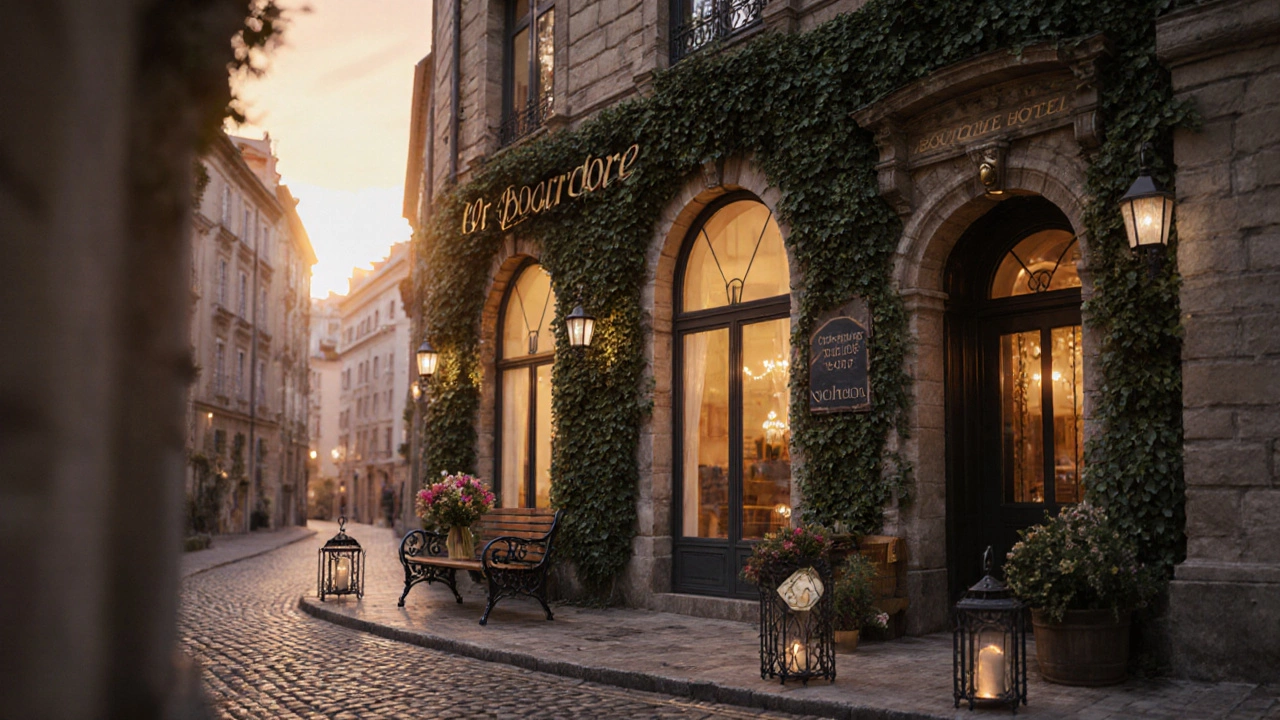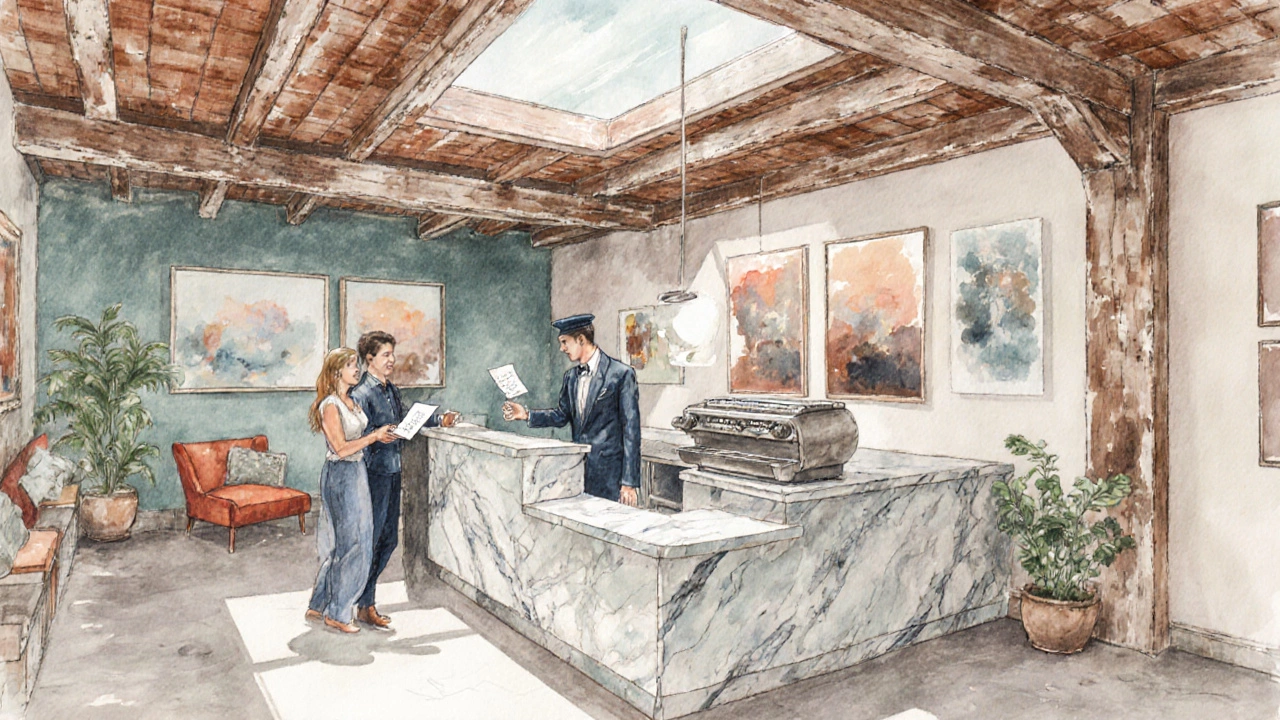Boutique Hotel Meaning Explained - What Makes a Hotel Boutique?

Boutique Hotel Checker
Use this tool to determine if a hotel qualifies as a boutique based on key characteristics. Enter details below to see how well it matches the four core pillars.
Qualification Results
Key Takeaways
- A boutique hotel is a small, design‑focused property that offers personalized service.
- Size, location, design, and local culture are the four pillars that set boutiques apart.
- Unlike large chains, boutiques are often independently owned and curate unique guest experiences.
- Guests benefit from higher staff‑to‑guest ratios, curated amenities, and a stronger sense of place.
- When choosing, look for authenticity, sustainability practices, and clear communication of the hotel’s story.
What Exactly Is a Boutique Hotel?
When you hear the term boutique hotel is a small, design‑focused lodging property that delivers personalized service and a unique sense of place, the image that pops up is usually a stylish building tucked in a historic district or a renovated loft with artful décor. The concept first emerged in the 1980s in major cities like New York and London, where travelers craved intimacy and character over the uniformity of big chains.
Today, boutique hotels can be found in bustling capitals, quiet coastal towns, and even remote mountain villages. What ties them together isn’t geography-it’s an ethos of craftsmanship, local immersion, and attention to detail.
The Four Core Characteristics
Even though each boutique tells its own story, most share four defining traits:
- Size matters: 10-100 rooms is the sweet spot. Smaller inventories let staff know guests by name and keep the atmosphere intimate.
- Location with character: Properties gravitate toward historic districts, artsy neighborhoods, or natural landmarks that give guests a strong sense of place.
- Design as a narrative: From hand‑crafted furniture to locally sourced artwork, the décor reinforces the hotel’s story.
- Personalized service: Staff‑to‑guest ratios are higher, enabling custom recommendations, tailored amenities, and spontaneous touches like handwritten welcome notes.
These pillars work together to create an experience that feels curated rather than manufactured.
How Boutique Hotels Differ From Chain Hotels
| Aspect | Boutique Hotel | Chain Hotel | Lifestyle Hotel |
|---|---|---|---|
| Room count | 10‑100 | 100‑500+ | 50‑200 |
| Ownership | Often independent or small‑group | Corporate franchise | Brand‑led but with local flair |
| Design philosophy | Unique, story‑driven, often historic | Standardized layouts and décor | Modern, trend‑focused, brand‑consistent |
| Service model | High staff‑to‑guest ratio, personal touches | Efficient, process‑driven | Blend of personalized and brand‑standard |
| Local integration | Partners with local artists, farms, tours | Limited, often generic recommendations | Curated experiences, but may feel scripted |
Notice how the boutique column emphasizes individuality, while the chain column leans on consistency. Lifestyle hotels sit somewhere in the middle, borrowing design cues from boutiques but maintaining brand coherence.

Why Guests Love Boutique Hotels
From a traveler’s perspective, the appeal is visceral:
- Authentic immersion: You wake up to local art, breakfast from a nearby bakery, and staff who can point you to hidden alleys.
- Higher service quality: Because the property is small, staff can remember that you prefer a pillow firm‑ness or that you’re celebrating an anniversary.
- Sustainability focus: Many boutiques adopt eco‑friendly practices-recycled linens, low‑flow fixtures, and sourcing food locally-making the stay greener.
- Memorable design: A loft with exposed brick, a beachfront villa with hand‑woven textiles, or a mountain lodge with reclaimed wood-all become part of the travel story.
These factors turn a simple overnight stay into a narrative you’ll share with friends.
Choosing the Right Boutique Hotel for Your Trip
Not every boutique will match your preferences. Here’s a quick checklist to help you decide:
- Clarify your travel vibe: Are you after art, food, adventure, or relaxation? Look for hotels that align with that theme.
- Check ownership: Properties labeled “independent” or “family‑owned” (see independent hotel) often stay truer to boutique values.
- Read recent reviews: Focus on comments about staff friendliness, cleanliness, and how well the hotel integrates local culture.
- Assess amenities: Some boutiques forego large pools for rooftop terraces or curated wine lists-make sure the offered perks matter to you.
- Confirm sustainability credentials: Look for certifications like Green Key or statements about local sourcing if eco‑consciousness is a priority.
Once you’ve narrowed the field, book directly through the hotel’s website. Direct bookings often unlock complimentary upgrades, welcome drinks, or flexible cancellation-benefits you rarely get from OTAs.
Common Misconceptions About Boutique Hotels
People sometimes lump all small hotels into the boutique bucket, but not every cozy spot qualifies. Here are three myths to bust:
- Myth 1: All boutique hotels are pricey. While many sit in the luxury bracket, there are mid‑range boutiques that balance design and affordability.
- Myth 2: Boutique means outdated. On the contrary, many invest heavily in modern tech-high‑speed Wi‑Fi, keyless entry, and in‑room tablets.
- Myth 3: Boutique hotels lack amenities. They may trade a large fitness center for a curated yoga studio, a locally‑sourced spa menu, or a community kitchen.
Understanding these nuances helps you set realistic expectations and enjoy the genuine charm.
Frequently Asked Questions
What size qualifies a hotel as a boutique?
Generally, a boutique hotel has between 10 and 100 rooms. The small scale allows for personalized service and a cohesive design narrative.
Are boutique hotels always independent?
Most are independently owned, but some belong to small boutique collections that share marketing resources while preserving each property's uniqueness.
Do boutique hotels offer loyalty programs?
Larger boutique chains may have loyalty schemes, but many independent boutiques focus on direct relationships rather than points. Enjoy perks like complimentary breakfasts or late checkout instead.
How do boutique hotels handle sustainability?
Sustainability is a core value for many boutiques. Expect practices such as recycled linens, locally sourced food, energy‑efficient lighting, and partnerships with eco‑certified suppliers.
Can I book a boutique hotel on major travel sites?
Yes, but direct booking often yields better rates, free upgrades, or exclusive experiences. Compare both options before finalizing.
Next Steps & Troubleshooting
If you’ve identified a boutique that feels right, follow these steps:
- Visit the hotel’s official website and read the “Our Story” page-this confirms authenticity.
- Check recent guest photos on Instagram or TripAdvisor; visual proof of design and cleanliness matters.
- Contact the front desk with any special requests (dietary, early check‑in, celebrating occasions). Their response time is a good service indicator.
- Secure the reservation with a credit card that offers travel protection; boutique policies can be more flexible than large chains.
- Set a reminder to follow up 48hours before arrival to reconfirm any custom arrangements.
Should anything go wrong-like a room not matching the photos-call the hotel directly before escalating to the booking platform. Most boutique properties pride themselves on quick, personal resolutions.